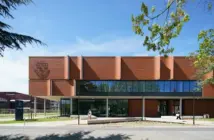Across the infrastructure and construction sectors, material passports are emerging as a promising tool for enabling circularity. They’re often described as a “bank of materials. After all, they catalogue the materials embedded within a building so they can be withdrawn at the end of life and reused elsewhere. I now see material passports as closer in spirit to a donor organ registry than to a passport or financial ledger, say HERA’s Troy Coyle.
This is because for “reuse” to work in construction, it’s not enough to know what materials exist. We also need to understand which components are actually compatible with which future projects — this makes it much like donors and recipients in medical systems.
The more I’ve worked with the concept, the more I’ve found that the banking analogy falls short. This compatibility challenge is where I believe the next evolution of thinking must occur.

Dr Troy Coyle — Registry not a bank. Compatibility is key
Reframing the future of Material Passports
If the construction and infrastructure sectors are serious about circularity, resilience and carbon reduction, I believe it’s time we stop thinking of material passports as mere banks and start seeing them as part of a sophisticated donor ecosystem. A system that ensures every viable material has the chance for a meaningful second life.
In articulating my own view, I’ve found the organ donor registry analogy helps reveal what’s missing in our current material passport frameworks: the recognition that reuse requires more than information.
It requires compatibility. It requires matching and preparation. It requires systems that ensure the right components find the right projects at the right time.
Material passports are a critical foundation but without compatibility-matching, they remain incomplete.

If the construction and infrastructure sector is serious about circularity, resilience and carbon reduction, it’s time we stop thinking of material passports as mere banks and start seeing them as part of a sophisticated donor ecosystem.
A system that ensures every viable material has the chance for a meaningful second life.
Materials bank is no longer good enough
Material passports are often framed as banks because they identify valuable materials for future “withdrawal.” The logic is sound: buildings act as repositories of steel, timber, concrete elements, glass, fixtures, and systems that shouldn’t be lost to landfill or downcycling.
However, in a bank, all currency of the same denomination is interchangeable. One dollar equals another dollar. Construction materials are not interchangeable in this way.
Two steel beams of the same nominal specification may have vastly different histories, including different loading conditions, different environments, different coatings, different compliance requirements.
Their future use potential can vary dramatically. This is where the financial metaphor starts to break down.
Sign up to the registry view
In my view, material passports need to function more like a donor registry. That is, a system not just for recording available assets, but for matching them intelligently with viable recipients.
Consider how organ donation works — construction has similar dynamics:
- not every organ is suitable for every recipient;
- condition, history, compatibility and timing all matter;
- A central system is required to evaluate, match, and facilitate exchanges.
A component removed from one building cannot simply be “withdrawn” from the material bank and dropped into another project. It needs to be compatible: structurally, dimensionally, chemically and in terms of code compliance. The receiving building must have the right “physiology” for the component to integrate safely and effectively.
Seeing material passports through this lens highlights why our current framing is incomplete.
Compatibility the missing piece
In my view, an over-focus on simply cataloguing materials does not go far enough. This is not a simple “what materials are in this building?” exercise. It’s a “which materials are suitable for which buildings” challenge — that’s donor registry territory.
It also puts a focus on ensuring compatibility through design and, if we truly want reuse at scale, we need systems that can evaluate:
- load history and fatigue
- mechanical and chemical properties
- end-of-life condition and deterioration
- certifications and inspection histories
- environmental exposure
- dimensional fit and assembly logic
- compliance with contemporary codes and performance standards
- Ease of disassembly and compatibility with the new design
Design buildings as future donors
If we adopt the donor analogy, our approach to design also changes. Buildings should be created in a way that maximises the future “donatability” of their materials. That means:
- designing for dis-assembly
- standardising elements where practical
- documenting load paths and structural utilisation
- creating digital twins that track changes across life
- specifying materials with reuse pathways already in mind
In addition, the recipient buildings would need to be specifically designed and prepared to receive donated elements. This perspective reinforces that circularity isn’t just an end-of-life task it’s a design philosophy.
Why this matters
For infrastructure, where material volumes and lifespans are significant, this shift in thinking could reshape procurement and regulation. I believe we will eventually see:
- mandated material passports for public assets
- national or trans-Tasman material matching registries
- certified testing protocols for reused components
- incentives for incorporating donor materials in new builds.
All of these require us to think beyond banking models and toward compatibility-based models.
Dr Troy Coyle brings more than 20 years’ experience in innovation management across a range of industries including materials science, medical radiation physics, biotechnology, sustainable building products, renewable energy, and steel.
She is a scientist with a PhD (University of NSW) and CEO of HERA.



